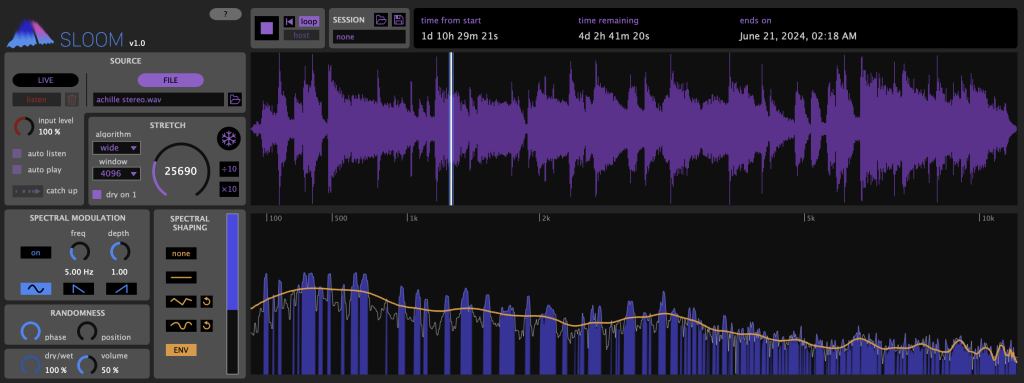You’ve heard time stretching. You’ve heard extreme time stretching. Sloom, a new plug-in and standalone app, is extreme-extreme-extreme time stretching – like instant ambient, instant experimental sonic manipulation – complete with unique spectral shaping.
Sloom is the new invention of Paris-based studio Anemond, founded by IRCAM and UC Berkeley research alumnus J.J. Burred. We’ve seen extreme time-stretch algorithms before, and honestly, I suspect folks who were fans of that will take the biggest interest in this. That trend is embodied best by the wonderful (and free, open source, multiplatform PaulXStretch. The history of that app, in turn is using the “PaulStretch algorithm (Paul’s Extreme Time Stretch, originally developed by Nasca Octavian Paul), and specifically the PaulXStretch version from Xenakios.” Got it? PaulXStretch is now on Linux and even iOS along with macOS and Windows, and it’s how we wound up with ethereal versions of the Windows startup chime.
So, do you need another extreme stretcher? Well, Sloom has a few features to recommend it.
- Multiple time stretching algorithms, including “wide” and “narrow” (wide widens the stereo field; narrow despite the name leaves it in place), “rough,” “robotic,” and my favorite, “hybrid” (combining robotic and wide)
- Live audio input operation – it creates an input buffer of up to 5 minutes, which also works in plug-in mode
- Spectral shaping with graphical modification
- Modulation with LFO, applied to the spectral profile

Combined, this adds up to something new. You can now use Sloom as a plug-in – I even tried some live improvisation with it, and intend to use it live onstage. The spectral shaping tools alone are useful because they allow you to edit out some of the artifacts that this process produces, especially at extreme settings – or exaggerate those sonic features if you prefer.
In conjunction with the LFO, which you can sync up, you can produce fantastic synced effects. It’s almost unfair to just refer to this as an extreme timestretch tool for that reason; it’s really also a spectral shaping effect with rhythmic (synced/free) modulation. You can even think of the extreme time-stretching as a way of producing spectral content for that effect; you could make it a glitchy rhythm feature. I’m going to mess around with making some techno with it this weekend.
Here’s a quick listen to how those settings sound as you dial through them – not so much a demo as a sonic illustration of those settings.
There’s WAV, AIFF, FLAC, and MP3 import in addition to the live audio buffer, and you have zero limitations on the length of the input.
The interface is a little cluttered, but all pretty usable, though I found it was more convenient to use the plug-in version. The LFO section is pretty basic, with just ramp and sine waves, but that covers the basics well enough. (Oddly, Logic Pro lacks live input support, but I used Ableton Live and Bitwig Studio with this one.)
There are some features you may not catch at first, too. You have looping support, which in the plug-in can follow the host transport. Everything is MIDI-mappable, too, via host, which opens up still more live performance use – a big edge for this particular time-stretch approach. I also love the freeze button, for instant “infinite” freezing. There’s also a “dry on 1” toggle which lets you play back the sound at the original speed but with the associated time-stretch artifacts, which again opens up the possibility of using this as a timbral effect and not just a time-stretching tool.
My only real complaint with Sloom is that the standalone version doesn’t have an audio recording function. You can use another tool, but I’d love a non-realtime render, especially for use with longer settings. That seems like a major oversight and I do hope we get an update there.
The usual disclaimer applies (which I find hilarious):
Sloom has been conceived as a sound design tool to explore radical timbre modifications, easily creating textures for ambient tracks, video soundtracks, events, or art installations that can potentially span hours, days, or even much longer. However, it should not be used for precise, transient-preserving stretching, which is outside its scope of application.
Yep, more run-with-scissors sound design. Bring it on – all normal parameters, be damned!
There’s a complete demo, minus only save capabilities, with a 20-minute timeout, if you want to try this for yourself and decide if it’s worth the investment. For my money, I love having this alongside the classic PaulXStretch. The more stretching, the better; this is an original addition to the “weirdo tool arsenal.” It’s good reason to remember why we love creating weird digital music.
39€, VST3 and AUv2, 64-bit, macOS (Intel/Apple Silicon) and Windows.
I think I need to check out some of anemond’s other creations, too.
Have a good weekend.




